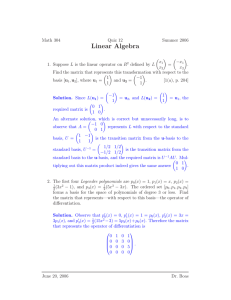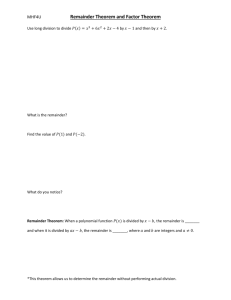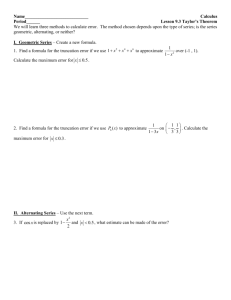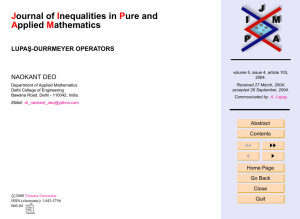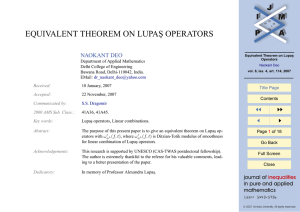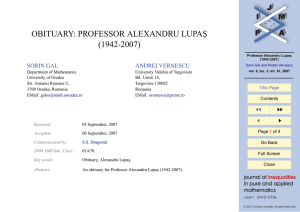Some evaluations of the remainder term Daniel Florin Sofonea
advertisement
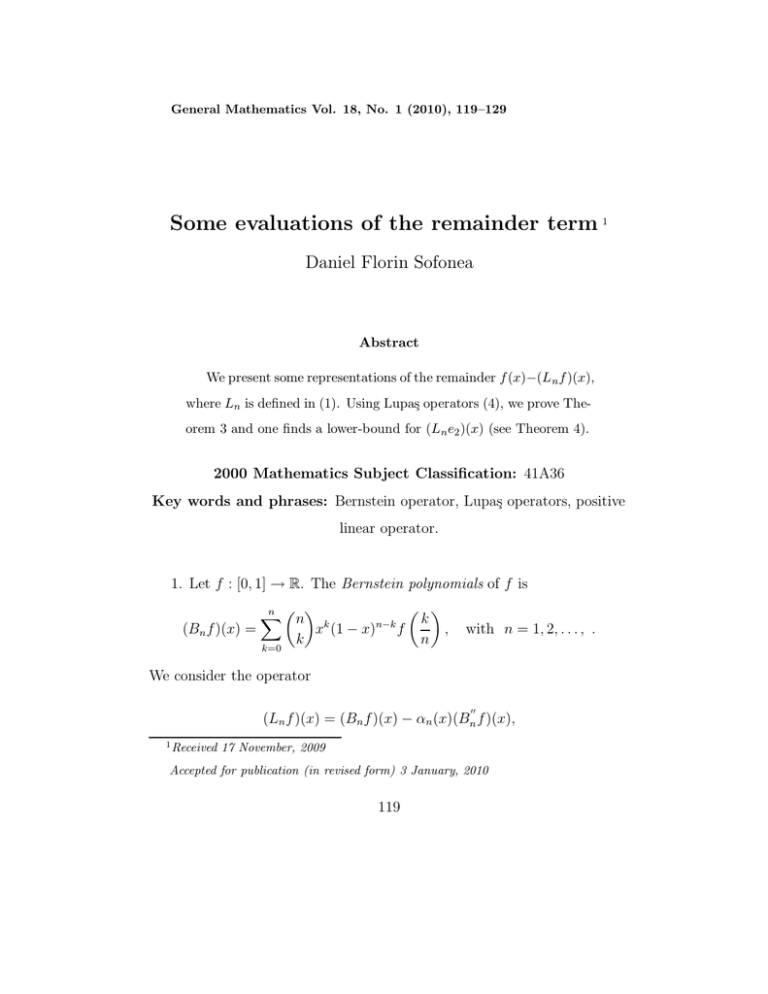
General Mathematics Vol. 18, No. 1 (2010), 119–129
Some evaluations of the remainder term 1
Daniel Florin Sofonea
Abstract
We present some representations of the remainder f (x)−(L n f )(x),
where Ln is defined in (1). Using Lupaş operators (4), we prove Theorem 3 and one finds a lower-bound for (L n e2 )(x) (see Theorem 4).
2000 Mathematics Subject Classification: 41A36
Key words and phrases: Bernstein operator, Lupaş operators, positive
linear operator.
1. Let f : [0, 1] → R. The Bernstein polynomials of f is
(Bn f )(x) =
n X
n
k=0
k
k
x (1 − x)
n−k
k
f
,
n
with n = 1, 2, . . . , .
We consider the operator
00
(Ln f )(x) = (Bn f )(x) − αn (x)(Bn f )(x),
1
Received 17 November, 2009
Accepted for publication (in revised form) 3 January, 2010
119
120
D. F. Sofonea
x(1 − x)
results from the following condition (Ln e0 ) = e0 ,
2(n − 1)
(Ln e1 ) = e1 , (Ln e2 ) = e2 , with ej (t) = tj , j = 0, 1, . . .. We obtain the next
where α(x) =
operator (see [2])
(1)
(Ln f )(x) = (Bn f )(x) −
x(1 − x) 00
(B f )(x),
2(n − 1) n
where (Bn f )(x) is Bernstein polynomials.
We use the notations
K = [a, b], ∞ < a < b < +∞,
Ωj (t, x) = Ωj (t) = |t − x|j ,
(2)
j = 0, 1, . . . , x ∈ K,
ω(f ; δ) = sup |f (t) − f (x)|,
|t−x|<δ
t, x ∈ K, δ ≥ 0.
From [3] we obtain
Theorem 1 If L : C(K) → C(K1 ), K1 = [a1 , b1 ] ⊆ K, is a linear positive
operator, then for all f ∈ C(K) and δ > 0 we have
||f −Lf ||K1 ≤ ||f ||·||e0 −Le0 ||K1 + inf {||Le0 ||K1 +δ −m ||LΩm ||K1 }ω(f ; δ),
m=1,2,...
where || · || = max | · | and Ωm are defined in (2).
K
Theorem 2 Let f ∈ C[0, 1]. If Ln are linear operator defined as in (1),
then
19
1
n
1
||f − Ln f || ≤ ω f ; √
+ ω f;
16
4
n
n
Some evaluations of the remainder term
121
Proof. We consider m = 4. Results
Ω4 (t; x) = |t − x|4 = (t − x)4 .
But for Bernstein operator we know
(Bn Ω4 )(x) =
1 2
2
3(n
−
2)x
(1
−
x)
+
x(1
−
x)
n3
(3)
n−2 2n(n − 1) X n − 2 k
n−2−k k k + 1 k + 2
(Bn f )(x) =
x · (1 − x)
,
,
;f
n2
k
n n
n
k=0
00
and using theorem 1 we obtain
1
19
||f − Bn f || ≤ ω f ; √
16
n
We have
x(1
−
x)
x(1
−
x)
00
00 ||f − Ln f || = f − Ln f −
B f+
B f 2(n − 1) n
2(n − 1) n x(1 − x) 00 ≤ ||f − Bn f || + B f .
2(n − 1) n But from (3) the theorem is proved because
n−2 x(1 − x) 00
x(1 − x) 2!n(n − 1) X n − 2 k
B f=
x ·
2(n − 1) n
2(n − 1)
n2
k
k=0
k k+1
k+1 k+2
,
;f −
,
;f
n
n
n n
n−2−k
· (1 − x)
2
n
n−2
x(1 − x) X n − 2 k
=
x (1 − x)n−2−k
2
k
k=0
122
D. F. Sofonea
·
f
k+2
n
−f
1
n
k+1
n
−
f
k+1
n
−f
1
n
k
n
!
n−2 x(1 − x) X n − 2 k
1
1
n−2−k
≤
n
x (1 − x)
· ω f;
+ ω f;
2
k
n
n
k=0
n−2 1 X n−2 k
= nx(1 − x) · ω f ;
x (1 − x)n−2−k
n
k
k=0 1
n
1
= nx(1 − x)ω f ;
≤ ω f;
.
n
4
n
On the other hand we observe
k+2
f nk
f k+1
f
k k+1 k+2
n
n
,
,
;f = 2 −
+
1
2
n n
n
2
2
2
n
n
n
n2
k
k+1
k+2
n2 2
k
=
f
− 2f
+f
= ∆1 f;
,
2
n
n
n
2 n
n
r X
r
r
∆h (f ; x) =
(−r)r−k f (x + kh),
k
k=0
with r = 1, 2, . . . , and h ∈ R.
Using the following definition ωr (f, δ) = sup0<h≤δ ||∆rh (f ; ·)||, with δ >
0, results
and
k k+1 k+2
n2
1
,
,
; f ≤ ω2 f ;
,
n n
n
2
n
x(1 − x) 00
nx(1 − x)
1
n
1
B f≤
ω2 f ;
≤ ω2 f ;
.
2(n − 1) n
2
n
8
n
from above formula the following proposition is proved
Corollary 1 Let f ∈ C[0, 1]. If Ln are linear operator defined as in (1),
then
19
1
n
1
||f (x) − (Ln f )(x)|| ≤ ω f ; √
+ ω2 f ;
16
8
n
n
Some evaluations of the remainder term
123
2. For approximation of the continuous functions f : [0, ∞) → R and which
satisfy an inequality like
|f (x)| ≤ AeBx
,
(x > 0), A > 0, B > 0
on [0, ∞) with A and B independent of f (that is f is of exponential type)
we use linear positive operators as (see [4])
∞
X
k
(4)
(Ln f )(x) =
an,k (x)f
, x ∈ [0, ∞)
n
k=0
where an,k : [0, ∞) → [0, ∞), and
i) the series
∞
X
k=0
ii)
∞
X
an,k (x)z k are convergent for |z| < r, where r > 1
B
, x ∈ [0, ∞)
∀ n ≥ n0 := 1 +
ln r
an,k (x) = 1
iii)
k=0
∞
X
k=0
k · an,k (x) = nx
Examples:
(nx)k
- Ln = Favard – Szasz operators
k!
n+k
xk
=
- Ln = Lupaş - Baskakov operators
n
(1 + x)n+k
I. an,k = e−nx
II. an,k
(Ln ei = ei , i = 0, 1)
Our purpose: a representation of the remainder
(Rn f )(x) := f (x) − (Ln f )(x).
Known methods:
124
D. F. Sofonea
(A) D.D. Stancu - with the help of divided differences.
(B) Peano0 s method. We suppose that f ∈ C 2 [0, ∞).
(C) The present method witch is actually a following of those in (A) which
where studied on particular cases. The idea is to use A. Lupa’s operators defined as
∞
X
with
k
(Sn f )(x) =
En,k (f ; x)f
n
k=0
j
2 k−1 k k+1
k
(Sn f )
=
, ,
; |t − x| f
,
n
n
n n n
n
t
0
, k = 0, . . . , k0
1 − {nx} , k = k0
2 k−1 k k+1
En,k (f ; x) =
, ,
; |t − x|+ =
n
n n n
{nx}
0
, k = k0 − 1
, k ≥ k0 + 2
where k0 = [nx].
Properties:
• They are positive linear operator (h(t) = |t − x| convex);
• Ln Sn f = Ln f (*)
Proof. We have
(Ln Sn f )(x) =
∞
X
k=0
k
,
an,k (Sn f )
n
Some evaluations of the remainder term
125
with (5) we obtain
∞
X
k
(Ln Sn f )(x) =
an,k f
= Ln f
n
k=0
j
j
(Sn f )
=f
,
n
n
(5)
(6)
S n ei = e i ,
i ∈ {0, 1},
j = 0, 1, . . .
e0 (t) = 1,
e1 (t) = t
We write successive
X
∞
j
k k=k0 =[nx],
(Sn f )
=
En,k f ;
=
n
n
k=0
x= nj
j
1 + n · n
j
j
= 1− n·
+ n·
f
n
n
n
but n ·
j
n
= 0, and from that results
j
j
(Sn f )
=f
n
n
we have
(Sn f )(x) = (1 − {nx})f
[nx]
n
+ {nx}f
1 + [nx]
n
But
1
|t − x|+ = (|t − x| + t − x)[x1 , x2 , x3 ; |t − x|+ ]t =
2
1
1
[x1 , x2 , x3 ; |t − x|]t + [x1 , x2 , x3 ; t − x]t
{z
}
2
2|
0
.
126
D. F. Sofonea
Theorem 3 We have the following representation:
zn (x)(1 − zn (x)) [nx] 1 + [nx]
(Rn f )(x) = −
,x
;f +
n2
n
n
∞ 2 X k−2 k−1 k
+
,
, ; f ϕk,n(x) ,
n k=2
n
n n
where
zn = {nx} and ϕk,n(x) = Ωk,n(x) − (Ln Ωk,n )(x) and Ωk,n(t) =
k − 1
.
−
t
n
Proof. Using the next representation:
∞ k − 1
2 X k−2 k−1 k
(7) (Sn f )(x) = a0,n (f )x+b0,n (f )+
,
, ; f ·
− x
n k=2
n
n n
n
and
∞ k − 1
2 X k−2 k−1 k
(8) (Sn f )(t) = a0,n (f )t + b0,n (f ) +
,
, ; f ·
− t .
n k=2
n
n n
n
We calculate (7)-(8):
(Sn f )(x) − (Sn f )(t) = a0,n (f )(x − t)+
(9)
∞ k − 1
k − 1
2 X k−2 k−1 k
+
,
, ;f · − x − − t
n k=2
n
n n
n
n
Applied on (9) linear operator Ln , refer to t and we take the result on x.
Some evaluations of the remainder term
127
From that result:
(Sn f )(x) − (Ln Sn f )(x) = a0,n (f )(x − (Ln e1 )(x))
|
{z
}
0
∞ k − 1
2 X k−2 k−1 k
+
,
, ; f · − x − (Ln Ωk,n)(x) .
n k=2
n
n n
n
f (x) − f (x) + (Sn f )(x) − (Ln f )(x)
∞ 2 X k−2 k−1 k
=
,
, ; f · (Ωk,n(x) − (Ln Ωk,n)(x))
n k=2
n
n n
From (*) result
∞ 2 X k−2 k−1 k
,
, ; f ϕk,n(x)
f (x) − (Ln f )(x) = [f (x) − (Sn f )(x)] +
n k=2
n
n n
where
ϕk,n(x) = Ωk,n (x) − (Ln Ωk,n )(x).
But f (x) − (Sn f )(x) is a representation introduce by A. Lupaş in ([3], p23).
And now we have
zn (x)(1 − zn (x)) [nx] 1 + [nx]
(Rn )(x) = −
,x
;f
n2
n
n
∞ 2 X k−2 k−1 k
+
,
, ; f ϕk,n(x)
n k=2
n
n n
where zn (x) = {nx}, and
ϕk,n(x) = Ωk,n (x) − (Ln Ωk,n )(x).
If Ωk,n are convergent, and if L is linear operator and positive with
Lej = ej , j = 0, 1, . . . then ∀ h convex
h(x) ≤ (Lh)(x) ⇒ ϕk,n(x) ≤ 0
(see [3]).
128
D. F. Sofonea
Theorem 4 If Ln , verifies the hypothesis, then
(Ln e2 )(x) ≥
nx[nx] + {nx}(1 + [nx])
n2
,
x≥0
with e2 (t) = t2 .
Proof. Let f (t) = e2 (t). From Theorem 3 we have:
∞
zn (1 − zn ) 2 X
(Rn e2 )(x) = −
+
ϕk,n(x).
n2
n k=2
But
(Rn e2 )(x) = x2 − (Ln e2 )(x),
then
∞
zn (1 − zn )
2X
ϕk,n(x) = x2 − (Ln e2 )(x) +
,
n k=2
n2
and because ϕk,n ≤ 0, we have
∞
X
n 2
{nx}(1 − {nx})
ϕk,n(x) =
x − (Ln e2 (x) +
,
2
n2
k=2
and
∞
X
n ([nx] + {nx})2 + {nx} − {nx}2
− (Ln e2 )(x)
ϕk,n(x) =
2
2
n
|k=2 {z }
≤0
n ([nx]2 + 2[nx]{nx}) + {nx}
=
− (Ln e2 )(x) ≤ 0
2
n2
From above we have
(Ln e2 )(x) ≥
and e2 (t) = t2 .
nx[nx] + {nx}(1 + [nx])
,
n2
x≥0
Some evaluations of the remainder term
129
References
[1] S.N. Bernstein, Démonstration du théorème de Weierstrass fondée sur
la calcul des probabilités, Comm. Soc. Math. Charkow Sér. 2 t. 13, 1912,
1-2.
[2] Franchetti C., Sull’innalzamento dell’ordine di aprossimazione dei polinomi di Bernstein, Rend. Sem. Mat. Univ. Politec. Torino, 28, 19681969, 1-7.
[3] A. Lupaş, ”Contribuţii la teoria aproximării prin operatori liniari”, Ph.
D. Thesis, Cluj-Napoca: Babeş-Bolyai University, 1975.
[4] A. Lupaş, ”On the Remainder Term in some Approximation Formulas”, General Mathematics 3, no.1-2, 1995.
[5] A. Lupaş, ”Classical polynomials and Approximation Theory.”, Colloqiumvortrag, Angewandte Analysis, Univ. Duisburg / Germany, 1996.
[6] F. Sofonea, ”Remainder in approximation by means of certain linear
operators”, Mathematical Analysis and Aproximation Theory, Burg
Verlag (Sibiu), 2002, 255-258.
[7] F. Sofonea, ”On a Class of Linear and Positive Operators”, WSEAS
Transactions on Mathematics, Issue 12, Volume 5, ISSN 1109-2769,
2006, 1263-1268.
[8] F. Sofonea, ”On a Sequence of Linear and Positive Operators”, Results
in Mathematics, ISSN 0378-6218, Birkhuser Verlag, 2009, 435-444.
[9] D.D. Stancu, ”Evaluation of the remainder term in approximation formulas by Bernstein polynomials”, Math. Comp. 83 1963, 270-278.
Florin Sofonea
University ”Lucian Blaga” of Sibiu
Department of Mathematics
Str. I. Raţiu, No. 5-7,
550012, Sibiu, Romania
e-mail: florin.sofonea@ulbsibiu.ro


